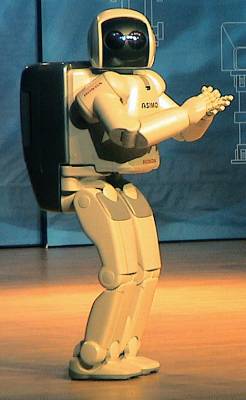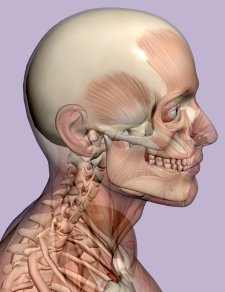The amazing thing to realize is that the world of Vertebrane could easily happen before the year 2050. The fact is that there are many different reasons to accelerate research in this area. Once the research is complete, it will become common for more and more people to move to the body-free lifestyle made possible by Vertebrane and Brain Storage Facilities.
One of the more prominent research organizations in this field may be NASA. The impetus for the research will be the first manned missions to Mars and the outer planets.
The mission to Mars
 photo by Stephen Girimont photo by Stephen Girimont |
Right now there is a great deal of excitement around the idea of sending men and women to the Red Planet. However, a Mars mission will not be easy. Perhaps the biggest problem is the cosmic radiation that will bombard the astronauts once they leave the protection of Earth’s magnetic field. [ref] Another problem is the size of the ship and the amount of fuel that it will take to get that ship to Mars and back.
Ship size is an important consideration on a trip to Mars for several reasons. Imagine what will happen to ship size if we try to send “normal” astronauts and their “normal” biological bodies to Mars.
The trip to Mars will take at least six months. The astronauts will spend a year or more on Mars waiting for Earth and Mars to realign for the return trip. Then it will be another six months getting back. Since the mission will be two to three years long, it would be nice to send six or seven people. But with the crew cooped up in the ship for so long, those six or seven people will need room to move around. Otherwise they may go insane with cabin fever.
This largish ship will then need shielding from cosmic radiation, and the shielding is heavy.
Then there are the supplies. A crew of six or seven people needs literally tons of food for a mission to Mars. Add in other necessities like fuel, electricity, water, waste disposal, entertainment, exercise equipment, medical supplies, clothing, space suits, landers, etc. for a mission that long, and you need to send a ship as big as a 747 to Mars. That could cost trillions of dollars using today’s technology.
Obviously a manned mission to Mars will not happen anytime soon if it costs trillions of dollars.
Is there an alternative that would allow us to go to Mars for a fraction of the money? Yes there is. We create a Brain Storage Facility that can travel safely in space, and we send just the brains of the astronauts to Mars.
As you think about this alternative, you will begin to realize that this approach is inevitable because of its many advantages. Therefore, it is likely that NASA will begin research into body-free spaceflight shortly.
Going to Mars Body-free
 photo by NASA photo by NASA |
Briefly, here is how a body-free trip to Mars would work. We would create a very small ship that could house the brains of perhaps 25 astronauts. Since each astronaut’s brain consumes only about 3 liters of space, the volume needed for the brains themselves is extremely small. Twenty five brains might fit into a space the size of a typical refrigerator. This, along with the life-support system for the brains, are likely to be the only parts of the ship that would require extensive shielding from cosmic rays.
The supplies needed to keep each brain alive — food, oxygen, vitamins, etc. — would be minimal compared to the supplies needed to keep a 150 to 200 pound human body alive. The tons of food needed to keep each astronaut’s body alive are cut down by a factor of 50 or more if we are just sending the astronauts’ brains. The amount of oxygen declines to a similar degree, as does the amount of water.
The rest of the ship would be highly simplified compared to a manned mission. There is no need for sleeping quarters, exercise areas, restrooms, showers, privacy areas, etc. The ship can be incredibly small, relatively speaking. Since the ship is now dramatically lighter and smaller, the amount of fuel necessary for the mission is much, much smaller.
Many psychological problems vanish with the body-free approach. Twenty five biological bodies cooped up in a small ship would drive each other nuts very quickly. Privacy would be impossible. The disembodied brains, on the other hand, can explore unbounded virtual worlds and unimagined entertainment options that completely eliminate psychological stress.
The medical equipment shrinks down to a small supply of drugs. The brains can be kept completely isolated from pathogens, and there is no need to worry about bodily injury or surgery. Problems with bone density and muscular degeneration in zero-G environments disappear.
 photo by Marshall Brain photo by Marshall Brain |
Once the ship arrives, the brains can load into robotic “bodies” to explore the planet. The brain can easily be shielded against radiation (unlike a body in a space suit), and life support for the brain is simplified when compared to life support for a body.
Or, the brains can all stay on the ship and tele-operate robotic bodies on the surface. We cannot tele-operate robots from Earth because of the twenty-minute time delay when communicating between the Earth and Mars, but tele-operation would be easy to do from a ship orbiting Mars or from a ship that has landed on the surface.
Today we see robotic bodies (such as ASIMO) as limited. The interesting thing about the body-free approach is that robotic bodies, in just 20 to 30 years, will be much better than human bodies for space exploration — stronger, faster, more durable, etc. It is also possible to imagine robotic body shapes that may be better suited to the task of exploring Mars. The sensors available in a robotic body — sight, hearing, touch, taste, smell — along with the precision and strength of the arms and legs will far exceed those of a biological human body.
This same body-free approach can facilitate trips to much more distant destinations as well. The idea of sending human bodies to Saturn and its moons is difficult to imagine — the ship would need to be gigantic. A body-free approach makes it imaginable.
Research
What are the roadblocks to a body-free mission to Mars? There are only a handful of fundamental research questions right now.
 photo by Patrick Hermans photo by Patrick Hermans |
First, how do we support a brain that is separated from its body? We need to create systems that can oxygenate and feed the brain, and systems that can eliminate waste products produced by the brain’s cells. We need to understand all the nutrients and hormones required to keep a brain healthy.
Second, how do we connect a brain to a computer? We need to figure out how to interface all of the incoming and outgoing nerve pathways of the brain to a computer so that a brain can directly experience a virtual world (or a robotic body) as though it is real.
These are both surmountable problems, especially in the time frame available. Under even the most optimistic plans, human bodies won’t be flying to Mars before 2030 as it is. With an intensive research program, we could probably have body-free brains ready to fly within 30 to 40 years.
The key to planning a mission to Mars — an event that won’t happen until 2030 in the very best case — is to look forward to all of the technological changes that are going to be occurring in the next several decades. The robotic revolution is going to change our world very quickly and the pace of research will quicken. We are already seeing the first signs of the transformation now.
In all likelihood, NASA will begin to invest in body-free research shortly, and astronauts may be the first people to experience the world of Vertebrane. This research has the potential to pay remarkable dividends in just two to three decades. Among other things, it will completely revolutionize space travel.
But this research — whether it is done by NASA or some other organization — will also make Vertebrane systems and Brain Storage Facilities possible on Earth much more quickly than you might suspect. The research will be rapidly commercialized and made available to everyone.
It will be fascinating to see when the first research projects begin.
Discard Your Body Table of Contents
- Chapter 1 – Is our science fiction right?
- Chapter 2 – Your fragile body
- Chapter 3 – The power of beauty
- Chapter 4 – Other traps that your body creates
- Chapter 5 – Saving Christopher Reeve, and you
- Chapter 6 – The pull of video games
- Chapter 7 – The problem with video games
- Chapter 8 – Understanding Vertebrane
- Chapter 9 – Experiencing the in-game world
- Chapter 10 – A fateful call from Clarissa
- Chapter 11 – The proliferation of game worlds
- Chapter 12 – The lure of porn
- Chapter 13 – Meanwhile, back at the ranch…
- Chapter 14 – The day you discard your body
- Chapter 15 – Who will be first?
- A Revolutionary Mission to Mars
- Imagining Elon Musk’s Million-Person Mars Colony
